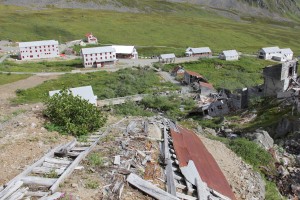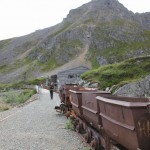Independence Mine is outside of Palmer, only a 20 minute detour from our route home. The weather was clear and breezy as we drove up ever-winding roads towards the pass. The road narrowed as it reached the top of the pass and soon we were at 3,500 feet in the Independence Mine State Historical Park. A cluster of freshly-painted wood buildings stood near the parking lot as several other tourists milled around.
The mine opened in 1934 and was active for a short amount of time, from 1934 to 1950, but in that time unearthed gold worth over $17 million (in today’s dollars). Though the work was hard accommodations were actually fairly luxurious, with heat, electricity, hot water, excellent food, and semi-private rooms.
The visitors center was closed when we got there so there were no guided tours. We walked among the mine buildings, some well-restored and others little more than giant piles of splinters. Outside of the buildings were illustrated signs describing what life was like for the miners. Shiny new fencing lined the dirt paths around the park, fencing off collapsed buildings that seemed to have been left right where they fell. Rusted steel cables that once supported mine carts lay across the walking path in several places. Dilapidated mine cart tracks hung twisted in the air, their wooden supports long since fallen.
In a way I am glad that little effort was made to spruce up the ruin of the mine buildings. It added to the realism. We could see we were looking at authentic materials and not a Disney-like recreation. Still, it made me wonder what future restoration efforts might be able to do.
We spent almost two hours wandering through the park: looking in old windows, tracing footsteps up to the “water tunnel” mine entrance, and walking past an old mine train. Viewing the ruins and the photographs of this temporary community helped convey a sense of the daily routine here. It was well worth making the side trip to see what life was like in a real mining camp.bv

